#chinese 5 spice powder
Explore tagged Tumblr posts
Text

Caramelized Sweet Potato Scallion Lentils (Vegan)
topped with a crisp scallion pancake and some cabbage slaw
#vegan#lunch#dinner#stews#lentils#sweet powder#green onion#garlic#onion#chili#ginger#coriander#chinese 5 spice#mirin#bell peppers#miso#avocado oil#black pepper#sea salt#coleslaw#cabbage#cilantro#vinegar#sesame seeds#sesame oil#savory pancakes#puff pastry#🧡
54 notes
·
View notes
Text
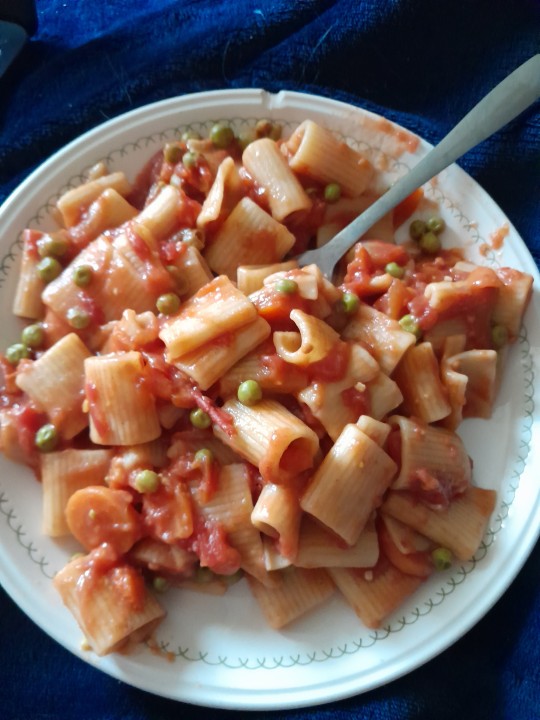
Chilli pasta
3 cups pasta
2 tablespoons garlic
2teaspoons chili powder
Teaspoon ground pepper
1 cup peas
1 cup carrots
2tins tomatos chopped
#rigatoni#chili powder#chinese 5 spice#garlic powder#mental health#healthy#cheap#quickmeals#cost of living#budget meals
0 notes
Text
Fourteen Days of MHA: Day 2
UA Academy, Education
In honor of UA/education day, I'mma learn you all some practical skills, à la the summer training camp arc.
How to make Japanese-style curry from scratch!


Yes, from scratch. Plus ultra. No pre-made curry roux box necessary for those of you who may not have access to such products where you live or who want to make modifications for food intolerance (this can be made gluten free! in fact that's usually how I make it). I will include two recipes: one for curry roux, and one for curry the complete dish. This is going to be my personal recipe for making curry, curry roux included, with some notes on other twists you can add to this dish.
Recipes below the cut. Let's get cooking!
Recipe: Curry roux
You need blocks of curry roux to make Japanese-style curry. If you'd like to go the easy route, buy a box of S&B curry blocks (the most widespread brand I believe) or from any other brand. But if you'd like to make this from scratch, here's how you do it.
Required Ingredients:
Note: This recipe makes about 3.5 oz of curry blocks or the equivalent of one small container of store-bought pre-made curry blocks. You would dissolve it in 2.5-3 cups of liquid to make curry. I double this recipe to make larger batches.
3 tbsp butter (or a neutral oil like canola)
3 tbsp flour (all-purpose gluten free flour works just as well)
3 tbsp curry powder (I use S&B curry powder)
1 tbsp tomato paste
Salt
Seasoning (see below)
Pika's Special Seasoning:
Garlic powder or garlic salt
Chinese chicken bouillon powder (or just MSG) (Lee Kum Kee has a gluten free option)
Ground mustard
Celery salt
Sugar
Black and/or white pepper
Chili pepper (I use shichimi togarashi), optional for spicy
These are the ingredients I typically use to flavor my roux. You may ask how much, and well, sorry, my measurements here are in my heart. I throw in dashes based on aroma and experience. I also like my curry strong and spicy.
Any ingredient can be omitted as all each does is add a new layer of flavor. No ingredients depend on any others (though sugar with tomato paste seems like a given to me). You CAN omit the tomato paste if you're sensitive to tomatoes.
Other Optional Seasoning:
Cayenne, optional for spicy
Ground ginger (fresh ginger would probably work too)
Onion powder (especially if you don't have MSG or chicken bouillon powder)
Garam masala (around 1 tbsp adds a sweeter flavor and a cinnamon-cardamom aroma)
Honey (I personally put honey in the curry after it's made, not at this stage)
These are ingredients others use that you may consider adding for different depths of flavor. I do not typically use them in this recipe, but I have been known to experiment with them on occasion. I've listed them in the order of how likely I am to throw them in on a whim.
Instructions:
Make one batch of roux for a small, mild curry. Make two batches of roux (i.e. double the ingredients) for a stronger and/or larger batch of curry.
Heat a skillet on the stove over medium-low heat. Optionally toast dry spices if desired, though not necessary, then remove spices and set aside. Melt butter (or heat oil, if using) in pan.
Add flour and combine. I personally use a nonstick pan-safe whisk to make sure it combines well, but a wooden spoon or silicone paddle would work too.
Reduce heat to low (medium-low if you're ready to watch that thing like a hawk). Cook 5-15 minutes stirring constantly to keep the roux from sticking to the pan and burning. You're looking for the roux mixture to turn light brown like peanut butter. It will develop a nutty aroma as it cooks.
Add curry powder, tomato paste, salt, and all desired seasoning ingredients. Stir to combine. The mixture should become dry and pasty.
Cook for 30 seconds to 1 minute or until all ingredients are well-combined and then turn off burner.
If using roux soon, set aside. If not using roux soon, put all the roux in a container lined with parchment paper. Score the paste with a knife to make it easy to break and remove. In an air-tight container, the roux will keep in the fridge for up to 1 month* or in the freezer for up to 4 months. *Caveat: If you use chicken bouillon powder or any ingredient that includes meat, I do not know if it will store in the fridge for longer than a few days. In this case, I would suggest freezing the roux to be safe.
Recipe: Japanese-style curry
Ingredients:
Note: My portions are determined by what fits in my pot.
2 tbsp neutral oil (canola)
1-2 lb protein (you can use any protein i.e. beef, pork, chicken, seafood, tofu, tonkatsu, etc., but I usually just stick with mushrooms for ease; if I do meat, I usually pick ground beef or cubed beef chuck)
1 batch of curry roux for mild curry (or 4 blocks packaged curry roux), 2 batches for strong (see above recipe) (or 8 blocks of packaged curry roux)
1 sweet onion (can substitute with yellow or white onion), sliced into half moons
1-2 carrots, peeled and sliced rangiri style
5-6 Yukon gold potatoes, cut into large chunks
8 oz button mushrooms (16 oz if mushrooms are the primary protein), cut into bite-sized chunks
2-3 stalks of celery, cut into bite-sized chunks
4-6 cloves or equivalent of minced garlic
1 quart chicken stock (dashi or vegetable stock or other stock or even water can also be used)
Meiji milk chocolate, 4-5 pieces (you can use any chocolate you like)
1-2 tbsp honey (add to taste)
1 grated apple, optional (I don't usually do this but it's a thing some people like to do)
Cheddar cheese, shredded
Cooked starch of choice i.e. rice or noodles
Pickled ginger, optional garnish
Fukujinzuke pickles, optional garnish
Instructions:
If your protein is raw and requires cooking or browning, prepare it first. Heat oil in a pot over medium heat and sear all the sides brown or cook ground meat until browned. For seared meat, do not worry about cooking it completely; it will finish cooking in the curry. Remove protein from pot. You can leave the drippings in the pot if you'd like to add their flavor to the curry. Ground meat might produce an excess amount of fat though, which you may want to clean out first.
Heat more oil in the pot and add the vegetables. Cook on medium heat for 5 or so minutes or until the vegetables start to develop color and the onions turn translucent.
Add back the protein and any accumulated juices to the pot.
Add chicken stock (or broth/liquid of choice) and bring to a boil. Reduce heat to a simmer and cover. Simmer until ingredients are tender and potatoes can be pierced with a fork, approximately 15 minutes.
Remove lid and reduce heat to low.
Add curry roux (or packaged curry blocks), chocolate pieces, honey, and grated apple if using. (If you'd like, you can break the blocks and chocolate up or shave them into small pieces with a knife.) Stir constantly, making sure to scrape the bottom of the pan often, until curry and chocolate are completely melted and incorporated in the liquid.
Simmer 5 minutes while stirring constantly. Cook longer if you want it to thicken more.
Serve over rice or noodles. Top with shredded cheddar cheese (in my opinion there is no such thing as too much cheese). Optionally garnish with pickled ginger and/or fukujinzuke pickles.
Store leftover curry in the fridge for 3 days. The curry and liquid may separate, but they'll combine again when you heat it up and mix it together. I'm not sure about freezing leftovers as it usually doesn't last long enough for me to get to that stage, but it's worth a try.
Now eat up, you damn nerds!


85 notes
·
View notes
Text
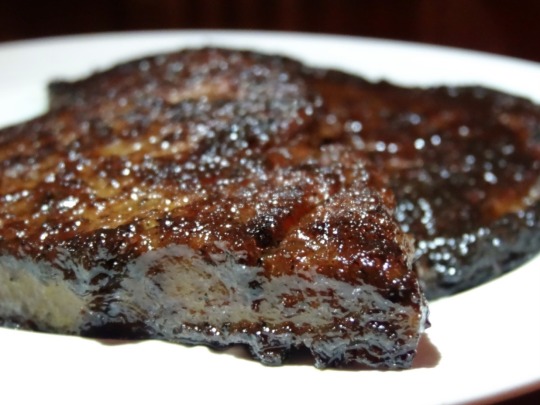
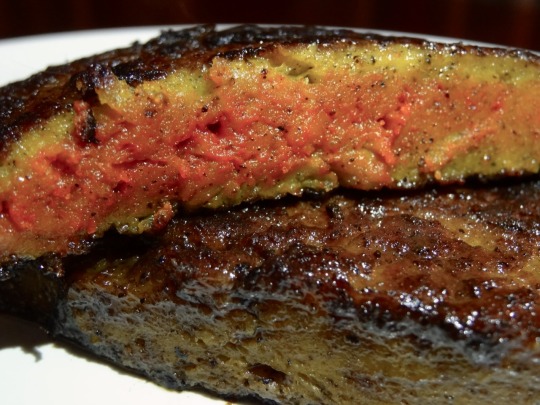
[ID: First image is of two dark brown glazed lamb chops. Second image is a close-up; one of the chops has been cup open to show a pink interior. End ID]
Seitan lamb chops
This vegan meat can be used as a substitute for lamb chops or rack of lamb. Like well-cooked lamb, it is fine-grained, moist, subtly sweet, and meltingly tender. Once simmered it is ready to be seared, breaded, fried, or sliced, and included in your favorite recipes.
The seitan is made using the washed flour method, which kneads dough in water to separate the gluten from the starch: this allows you to control how much starch you leave alongside the gluten in the dough, and thus how tender versus chewy your final cut of meat will be. This recipe makes a dough that leaves more starch in than most seitan recipes do, and then kneads the dough again to distribute that starch into an even, fine grain. A simmer in a spiced, aromatic broth leaves the final product tender, moist, and flavorful all the way through; the broth is then cooked down to a glaze.
The spices called for in this recipe are geared towards replacing lamb in Palestinian recipes, but they can easily be swapped out to complement the flavor profiles of other dishes.
Recipe under the cut!
Patreon | Tip jar
Makes 4 large lamb chops.
Ingredients:
For the dough:
720g bread flour (or any white wheat flour with at least 12% gluten)
About 2 1/4 cups water
For the dry flavoring mix (scaled to 455g dough yield):
2 tsp (7.5g) ground sumac
1 3/4 tsp (5.25g) onion powder
1 tsp (4g) kosher salt (1/2 tsp table salt)
1 tsp (5.5g) vegetarian granulated sugar
1 tsp (2.5g) black peppercorns, toasted and ground
3/4 tsp (2g) caraway seeds, toasted and ground
3/4 tsp (3g) garlic powder
3/4 tsp (2.5g) ground turmeric
3/4 tsp (2g) cumin seeds, toasted and ground
3/4 tsp (1.5g) aniseed, toasted and ground
1/2 tsp beet powder; or 5 drops red + 1 drop green food coloring
1/2 tsp (2.5g) MSG (optional)
To fry:
4 tsp vegan margarine or ghee (سمنة), divided
4 tsp olive oil, divided
For the simmering broth:
2 Tbsp soy sauce (I used Chinese aged soy sauce)
1 Tbsp red tahina
2 tsp miso paste (preferably red)
2 tsp pomegranate molasses
2 tsp vegetarian 'beef' stock concentrate (optional)
1 small yellow onion, quartered
2 cloves garlic, crushed
1 bay laurel leaf
1 stick cinnamon bark
5 allspice berries
5 green cardamom pods, crushed
2 cloves
1/2 tsp black peppercorns
1 tsp vegetarian granulated sugar
Several cups water
Instructions:
To wash the flour:
To make seitan using the washed flour method, a dough is first made out of flour and water; then, the dough is washed in water multiple times. The water carries off the starch, leaving the gluten behind.
1. Make the dough. Mix flour and water in a large mixing bowl until dough comes together. Knead for several minutes, and then cover the dough and allow it to rest for another 10-15 minutes to develop gluten. After resting, the dough should be very smooth, elastic, and stretchy.
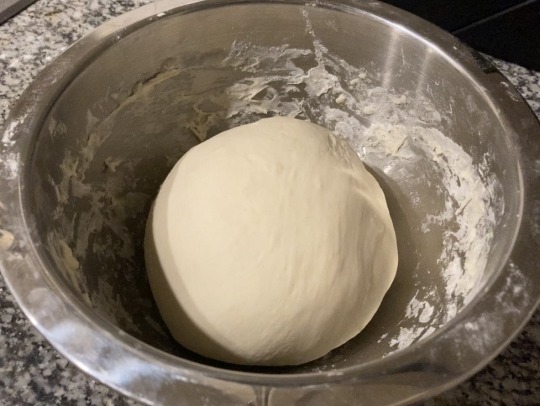
2. Soak the dough. Fill the bowl with enough cool water to cover the dough, and let it soak for about an hour. This allows gluten to continue developing.

3. First wash. Leave the soaking water in the bowl, and begin to knead the dough with your hands under the water. Repeatedly pull, stretch, fold, and press the dough for several minutes to knead, occasionally using your fingertips to break through and shred or mangle the dough as you pull. Soon, the water should be a thick, opaque white.
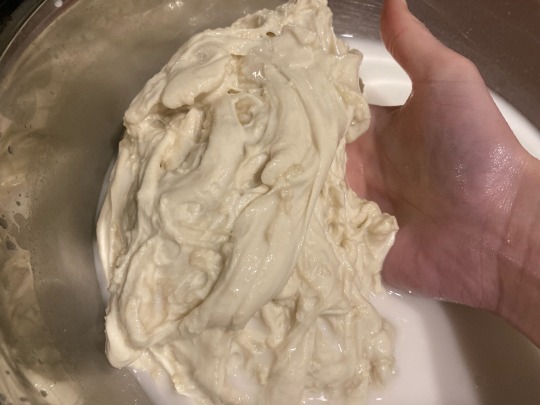
4. Drain the dough. Set up a colander over a very large container, and pour the contents of your mixing bowl through. You can also just pour the starchy water down the sink if you don't have plans to use it (to make liangpi noodles, or dumpling wrappers, or any of the recipes out there for vegan bacon using wheat starch...).
At this point, you will see two distinct substances in the dough: the gluten, which is thin and stringy and feels rubbery when pinched, and the starch, which is thick and 'globby' and feels soft when pinched, offering no resistance. We want to wash the flour a few times until most of the starch has been removed, and there are only some small globules interspersed throughout the stringy gluten.
5. Second wash. Return the dough to your mixing bowl and fill it with fresh cool water. Knead and pull the dough for another few minutes, until the water once more turns opaque. There should be fewer large areas of starch in the dough, and more development of the gluten strands. Drain the dough again (just like in step 4).
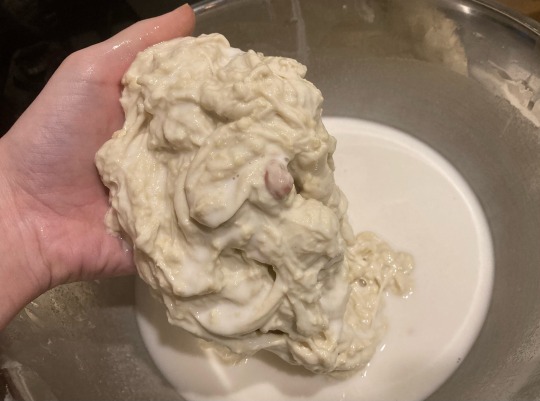
6. Third and fourth wash. Repeat this process another time or two, until the starch globules are about 20% of what you see, and the gluten is around 80%. For the last wash, the water should be a bit less opaque with starch than it was for the first one, but it should be more than a bit cloudy. You should see your fingers when you cup some of the water in your hand, but not the bottom of the bowl.

After the third wash
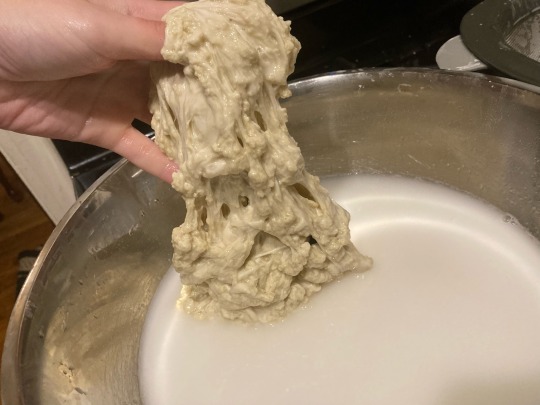
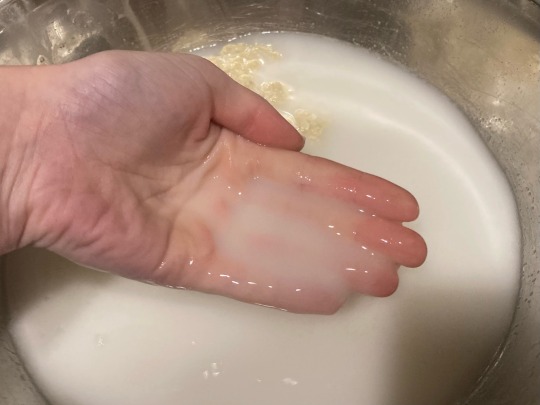
After the fourth wash
7. Drain the dough. Drain the seitan again and allow it to continue draining, flipping over once, until it is noticeably less wet. Squeeze the dough to remove any extra water or starch on the surface.
You now have your washed flour! This will be the base for the rest of the recipe. I had 455g of dough at this point.
To finish the dough:
1. Add all dry ingredients to the dough and knead again to distribute evenly; or use a blender for about 30 seconds until everything is well-incorporated and the gluten strands are visible.
2. Pull the dough into a single long, thick strand, and then tie it into a couple knots. Do this a few times to build structure.
To cook:
The dough will first be seared to develop a crust, then simmered to infuse it with more flavor. After a rest in the simmering liquid, it is seared again to re-crisp, then tossed in the thickened liquid to form a glaze.
1. Divide dough into four pieces. In a large skillet, heat 2 tsp of margarine and 2 tsp of olive oil (or use all olive oil). Add dough pieces and push flat with a spatula. Fry, turning as needed and intermittently pressing flat with the spatula, until the surface is browned and crispy.
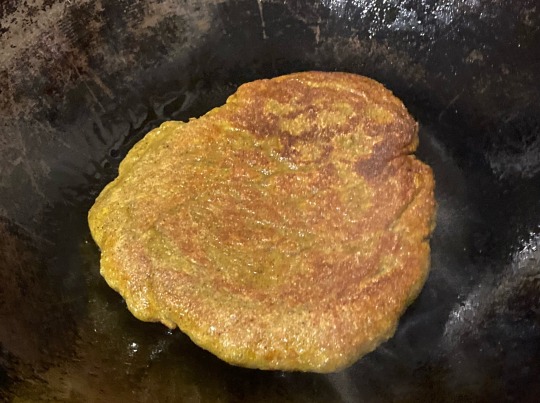
2. Mix liquid simmering ingredients together and whisk to combine. Pour over browned chops and add whole spices and aromatics. If necessary, add more water to cover.
3. Slowly bring simmering liquid up to a bare simmer. Don't let it come to a rolling boil, which could produce a spongey texture.
4. Cook at a very low simmer, uncovered, for 20 minutes, stirring occasionally. Remove from heat and allow to soak in the simmering liquid (including spices and aromatics) for at least an hour in the fridge, or overnight.
This is a good place to stop for the night if you want to make these ahead of time.
5. Remove lamb chops from liquid. In a large pot or deep skillet, bring simmering liquid (including spices and aromatics) to a boil, uncovered, until considerably reduced.
6. Strain to remove whole spices and aromatics. Return to pan and continue to reduce until thickened to a glaze-like consistency.
7. In a clean skillet, fry lamb chops again in remaining margarine and oil until browned and crispy. Add glaze and cook, flipping and agitating occasionally, for a couple minutes until coated.
Serve immediately over rice or frika (فريكة / freekeh), topped with fried pine nuts, alongside plain cultured soy yoghurt, pickles, olives, and a side salad, etc.
152 notes
·
View notes
Text
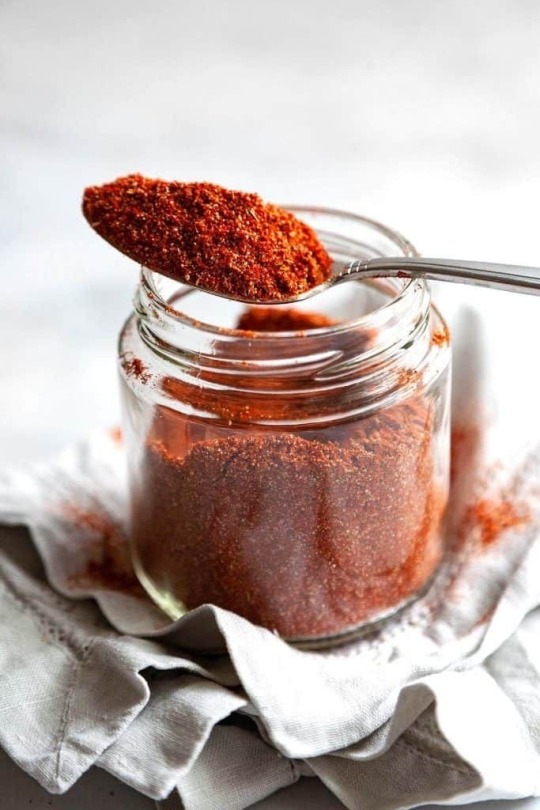
Spice blend hacks for your dishes -
1. Cajun seasoning: a blend of paprika, cayenne pepper, garlic powder, onion powder, oregano, thyme, and red pepper flakes. Perfect for adding a kick to chicken, shrimp, or vegetables.
2. Garam masala: a traditional Indian spice blend featuring warm and aromatic spices like cinnamon, cardamom, cloves, cumin, coriander, and nutmeg. Great for adding depth of flavor to curries, soups, and rice dishes.
3. Italian seasoning: a classic blend of dried herbs such as basil, oregano, rosemary, thyme, and marjoram. Ideal for seasoning pasta sauces, roasted vegetables, and grilled meats.
4. Taco seasoning: a mix of chili powder, cumin, paprika, garlic powder, onion powder, and oregano. Perfect for seasoning ground beef or chicken for tacos, burritos, or nachos.
5. Chinese five-spice powder: a blend of star anise, cloves, cinnamon, Szechuan peppercorns, and fennel seeds. Adds a unique flavor to stir-fries, marinades, and roasted meats.
6. Ras el hanout: a North African spice blend featuring a mix of warm and aromatic spices like cumin, coriander, cinnamon, ginger, and cloves. Great for seasoning tagines, couscous, and grilled meats.
7. Herbes de Provence: a blend of dried herbs such as thyme, rosemary, marjoram, savory, and lavender. Adds a fragrant and earthy flavor to roasted chicken, vegetables, and potatoes.
#food log#comfort food#fast food#healthy food#food diary#food photography#foodie#food#foodpics#foodlover#japanese food#foodmyheart#pasta recipes#lunch recipes#pasta recipe#salad recipes#soup recipe#recipe#healthy salad recipes#recipies#recipes#reciprocity#cozy fall#cozyhome#cozy cozy#cozy living#autumn cozy#cozy art#cozy mystery#cozy vibes
13 notes
·
View notes
Text
Deutschribing Germany
Cuisine
Meal times
The German proverb Iss dein Frühstück wie ein Kaiser, Mittagessen wie ein König und Abendessen wie ein Bettler (Eat your breakfast like an emperor, lunch like a king, and dine like a pauper) sums up the German outlook toward meals.
A typical day begins with Frühstück (breakfast), when people drink coffee, tea, or hot cocoa and eat muesli with yogurt or milk or bread with butter, jam, honey, chocolate and hazelnut spread, sausage, or cheese. Some people also drink juice and eat a boiled egg. This usually takes place between 6 and 8 a.m. Children usually eat a mid-morning snack at school called Pausenbrot (recess sandwich) that consists of a sandwich, a piece of fruit, or a muesli bar. The adult version is called Zwischenmahlzeit (in-between meal).
Mittagessen (lunch) takes place between 12 and 2 p.m. A typical lunch dish includes potato salad with sausage or meatballs and meat with potatoes or vegetables. It is common for family members and friends to gather between 3 and 5 p.m. for Kaffee und Kuchen (coffee and cake).
Abendessen (dinner) is eaten between 6 and 7 p.m. Sometimes it is a light cold meal with bread and cold cuts, in which case it is called Abendbrot (evening bread). Dinner normally consists of a salad or soup, bread, cheese, meat or sausages, mustard, and pickles.
Dishes
German cuisine varies from region to region, and what is considered typically German is actually typical in the south, mainly Bavaria, where cuisine is similar to that in Austria. There are also international varieties such as doner kebab, pizza, sushi, Chinese food, Greek food, Indian food, and Vietnamese food.
Bread and sausage are staples of the German diet. There are about 600 types of bread and almost 1,500 sausage varieties, including Bratwurst (made of ground pork, beef, or veal and spices) and Weißwurst (white sausage eaten with sweet mustard, a pretzel, and beer).
The national alcoholic drink is beer, of which there are many varieties, including Helles (a pale lager beer produced in southern Germany), Radler (a beer mixed with lemonade), and Weizenbier (a top-fermented beer brewed with a large proportion of wheat relative to the amount of malted barley).
Berliner/Krapfen/Pfannkuchen
These sweet dough dumplings, filled with jam and glazed with powdered sugar, are known as Berliner in northern and western Germany, Pfannkuchen in eastern Germany, and Krapfen in southern Germany.

Birnen, Bohnen und Speck
Birnen, Bohnen und Speck (pears, beans, and bacon) is a dish made with pears, green beans, and bacon, accompanied by potatoes. It is eaten in Bremen and Lower Saxony.

Bratkartoffeln
Bratkartoffeln (fried potatoes) are fried potato slices with diced bacon and/or onions.
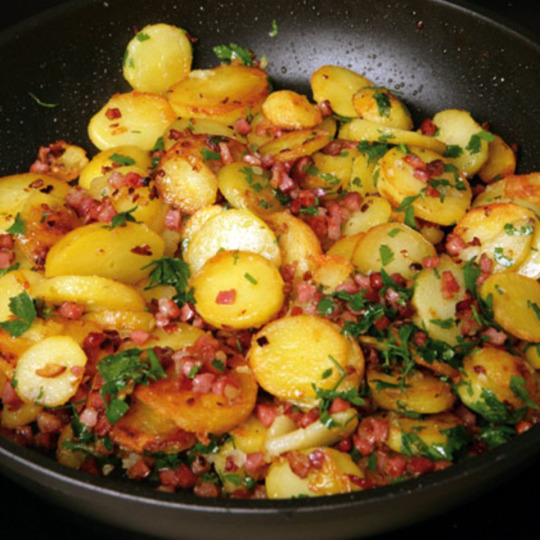
Brezel
Brezeln (pretzels) are baked pastries made from dough and shaped into a symmetrical knot. They are typically seasoned with salt, but can also have toppings such as cheese or seeds.
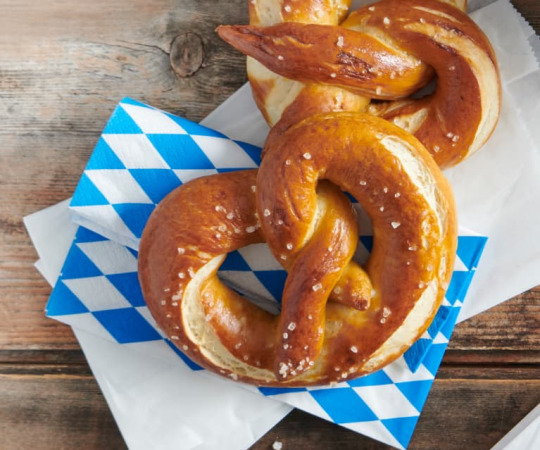
Brot
Brot (bread) comes in many different types, from white wheat bread (Weißbrot) to gray (Graubrot) to black (Schwarzbrot), which is actually dark brown rye bread. Some breads contain both wheat and rye flour and are called Mischbrot. Others have seeds such as linseed and sunflower seeds and are wholegrain (Vollkornbrot). Bread can also be made from spelt (Dinkelbrot), rye (Roggenbrot), or a mix of these with wheat.

Brötchen (bread rolls) are also very common and can be made from the same cereals and seeds as normal bread.
Currywurst
Currywurst is Berlin's most famous dish and consists of a pork sausage with ketchup and curry powder.
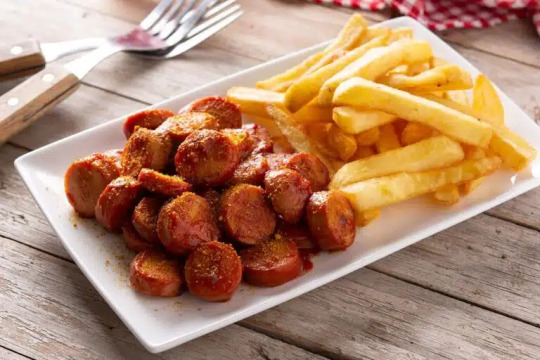
Eierschecke
Eierschecke, whose name is derived from a tripartite piece of clothing, consists of three layers: the bottom one is either a yeast dough or made with baking soda, the middle layer is a cream made of quark, vanilla, butter, egg, sugar, and milk, and the top one is made from eggs, butter, sugar, and vanilla pudding powder. It is a specialty from Saxony and Thuringia.
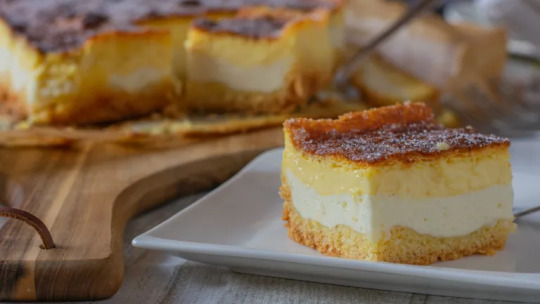
Fischbrötchen
A Fischbrötchen (fish bread roll) is a sandwich made with various fish, either pickled or fried, and onions, common in northern Germany.

Flammkuchen
Flammkuchen means "pie baked in the flames" and originates from Baden in Baden-Württemberg and the Palatinate in Rhineland-Palatinate. It is similar to a pizza with thin crust covered with crème fraîche, onions, and lardons.

Frikadellen
Frikadellen are flat-bottomed, pan-fried meatballs of minced meat. They are commonly eaten with pasta salad or potatoes, or in a bread roll with mustard.

Himmel und Erde
Himmel und Erde (heaven and earth) is a dish with mashed potatoes, stewed apples and fried blood pudding. Potatoes are also called Erdäpfel (ground apples), so it is a meal made with apples that grow above and under the earth. It is popular in the Rhineland in Rhineland-Palatinate and North Rhine-Westphalia, Westphalia in North Rhine-Westphalia, and Lower Saxony.
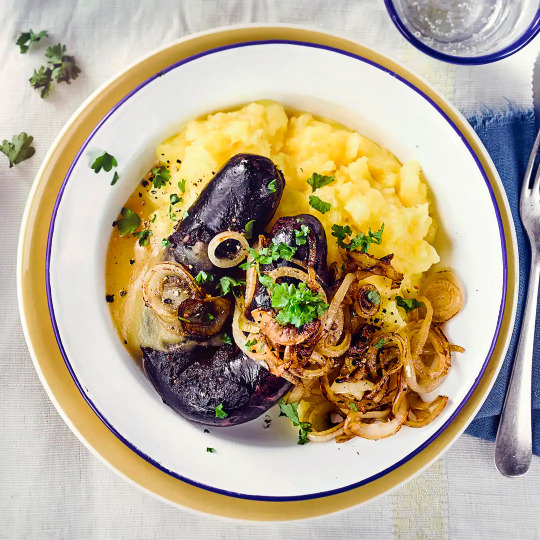
Kirschenmichel
Kirschenmichel is a kind of bread pudding made with cherries and served hot with vanilla sauce. It is typically eaten in Franconia in Bavaria and Thuringia, the Palatinate, Baden-Württemberg, and Hesse.

Klöße/Knödel
These dumplings are known as Klöße in northern, central, and western Germany and Knödel in southern Germany. They are usually made from flour, bread, or potatoes. There are different varieties, including dumplings made of ground liver or breadcrumbs.
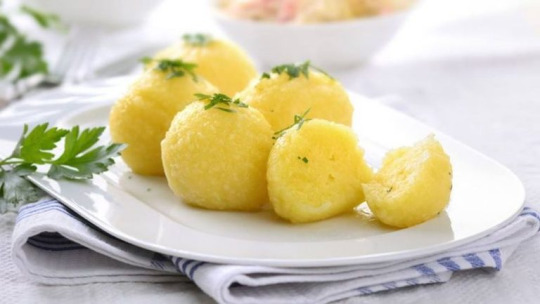
Kohlroulade
A Kohlroulade (cabbage roll) consists of cooked cabbage leaves wrapped around a meat filling seasoned with garlic, onion, and spices. Rinderrouladen are similar but consist of bacon and onions wrapped in beef.

Labskaus
Labskaus is a dish made from corned beef, herring, mashed potatoes, and beetroot, served with a fried egg and a pickled cucumber. It is typically eaten in northern Germany.
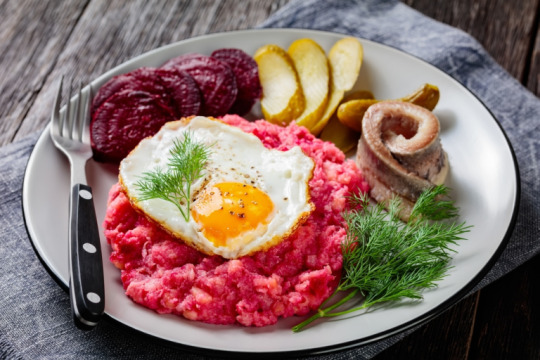
Leberkäse
Leberkäse ("liver-cheese") is eaten in Franconia, Saarland, and Swabia in Bavaria and Baden-Württemberg. It consists of beef, pork, and bacon that are finely ground and then baked as a loaf in a bread pan. It is served with an egg and mashed potatoes.

Leipziger Allerlei
Leipziger Allerlei was invented in Leipzig and consists of a mixture of peas, carrots, green beans, asparagus, morels, and celery. It may also contain broccoli, cauliflower, or corn. It is served with potatoes and a sauce made from crayfish butter, crayfish tails, and semolina dumplings.
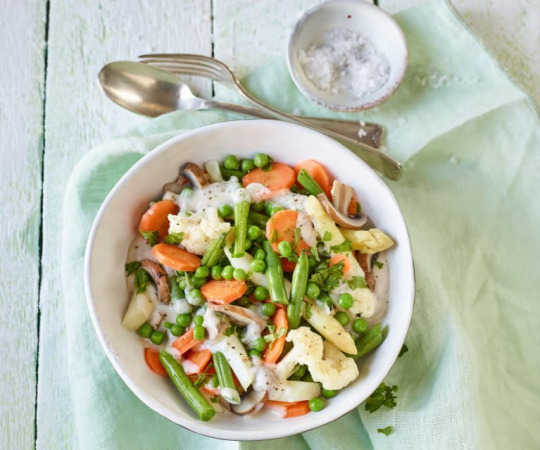
Marmorkuchen
Marmorkuchen (marble cake) has a streaked appearance, achieved by lightly blending light and dark batter. It can be a mixture of vanilla and chocolate.

Maultaschen
Maultaschen ("mouth bags") are large meat-filled dumplings typical of Swabian cuisine. They can also be filled with spinach, onions, and spices and can be either served with broth or cut into slices and fried with eggs.

Pfefferpotthast
Pfefferpotthast (boiled meat pepper pot) is a traditional Westphalian stew made with beef, lard, onions, and spices. It is served with boiled potatoes and salad in the summer and pickled cucumbers and beetroot in the winter.
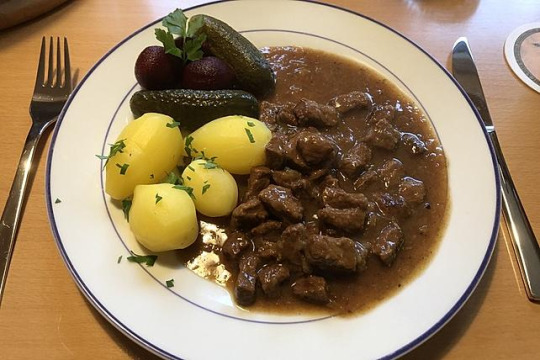
Pinkel mit Grünkohl
It is a dish made from slowly cooked kale served with Pinkel, a salty sausage eaten mainly in Bremen and Lower Saxony.
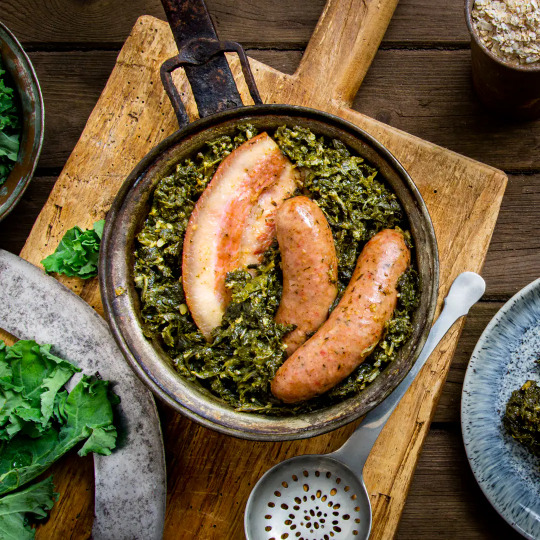
Quarkkäulchen
A Quarkkäulchen ("little quark ball") is a Saxon dish made from quark, mashed boiled potatoes, flour, an egg, and lemon peel. The dough is then baked in the form of a pancake and eaten hot with sugar and cinnamon or with fruit, whipped cream, and vanilla ice cream.

Reibekuchen
These potato pancakes are served with black bread, sugar beet syrup, or stewed apples. They are common in many areas of the country, but the name is characteristic to the Rhineland.

Rollmops
Rollmops ("rolled pug/fat young boy") are pickled herring fillets, rolled around a savory filling, usually consisting of onion and a pickle. It is a specialty from Berlin.

Sauerbraten
Sauerbraten is regarded as the national dish of Germany. It originally comes from the Rhineland and consists of large pieces of beef or horse meat, marinated in a spicy water-vinegar mixture before baking and served with Klöße.
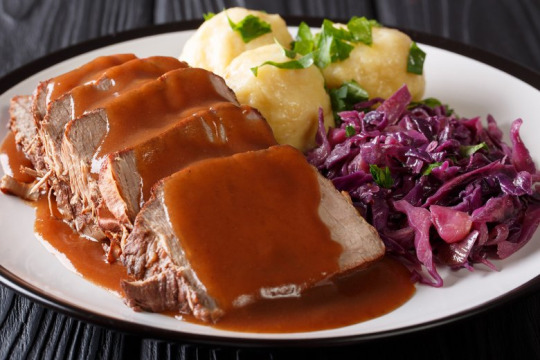
Sauerkraut
Sauerkraut is finely cut raw cabbage fermented by lactic acid bacteria.

Saumagen
Saumagen ("sow's stomach") is popular in the Palatinate and consists of a pork's stomach filled with pork, sausage meat, and potatoes. It is usually served with mashed potatoes or Bratkartoffeln and Sauerkraut.
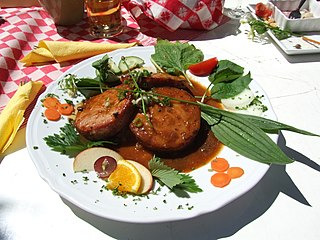
Schnitzel
A Schnitzel is a fried, breaded thin piece of meat, typically pork or beef. Although the most famous one is Wiener Schnitzel (Viennese style), there are other kinds, including Jägerschnitzel, with mushroom sauce; Rahmschnitzel, with cream sauce, and Zigeunerschnitzel, with a sauce made with tomato, bell peppers, and onion.

Schupfnudel
Schupfnudel are thick noodles typical of southern Germany. They are usually made from flour or potatoes and eggs and served with Sauerkraut.
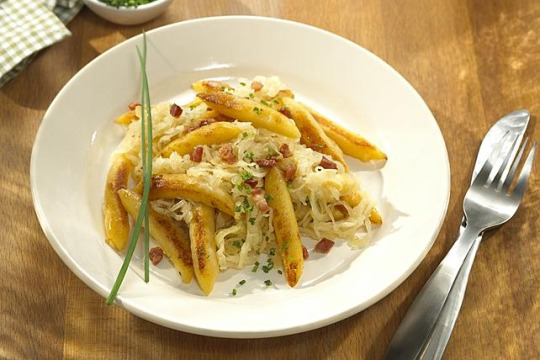
Schwarzsauer
Schwarzsauer ("black sour") is a North German blood soup with spices cooked in vinegar.

Schwarzwälder Kirschtorte
Black forest cake is a chocolate and whipped cream cake with a cherry filling and cherries on top.
Schweinshaxe
Schweinshaxe is a typical Bavarian dish of roasted ham hock served with Sauerkraut. A variation of this dish is known elsewhere as Eisbein ("ice leg"), in which the ham hock is pickled and slightly boiled.
Schwenkbraten
Schwenkbraten is a pork neck steak marinated in spices and onions. It is originally from the Saarland and grilled on a Schwenker, a grill that hangs on a chain over a wood fire.
Spaghettieis
Spaghettieis (spaghetti ice cream) is an ice cream dish made to resemble spaghetti. Vanilla ice cream is extruded through a modified Spätzle press to give it the appearance of spaghetti. It is placed over whipped cream and topped with strawberry sauce to simulate tomato sauce and either coconut flakes, grated almonds, or white chocolate shavings to represent Parmesan cheese.
Spätzle
Spätzle (little sparrow) are hand-made egg noodles, originally from Swabia. They are the main ingredient of several dishes, such as Käsespätzle (Spätzle with cheese) and Linsen mit Spätzle (lentils with Spätzle).
Streuselkuchen
Streuselkuchen ("crumb cake") is made of yeast dough covered with a sweet crumb topping (Streusel). The recipe originated in German Silesia.
45 notes
·
View notes
Text

Honestly, not one I've been looking forward to. I'm not into overly spicy dishes, and I'm not great at cooking Asian foods, especially Chinese. Also, fuck tripe. Explain to me why I'm paying fifteen dollars a pound for fucking tripe. This recipe was an expensive one.

This trip to the Asian market ran me $70. A few ingredients I bought were for other recipes, but not much. Pretty much spice on spice on spice, plus mushrooms. Not pictured is the single nondescript beer I bought for deglazing.
My food processor couldn't quite break down the mushrooms into a fine powder. It couldn't get the pan fried chillies down to a paste either. Didn't seem to have any discernable negative effect on the final product though.
I burned my first batch of chilies, but thankfully I have a huge bag of them. Totally maced my whole apartment though. The lack of windows in the kitchen hit me hard this time. I had to wrap my face in a towel while reducing this stuff. Lethal.

This picture conveys how my eyes and lungs felt while getting all the spicy stuff cooked down.

Literally a witches cauldron. Look at all that peppercorn oil. Once it all came together and I could breathe properly again, it actually smelled pretty good.

After it cooked for a few hours, I added the slurry and it bound the oil a bit better.

Served with a side of sticky rice. The scallions make it a little less intimidating. I tried to get pork floss for one of the optional garnishes, but after tasting it, I think it would have been extraneous.
| Ma Po Tripe and Pork |
Taste is a 2.5 out of 5. A bit too spicy for me. I knocked off an extra half point just for the tripe. Waste of time and money.
Difficulty is a 3 out of 5. No weird techniques, but a lot of prep work.
Time was about 4 hours. 2.5 hours of passive cooking, and a lot of set up.
When I first tasted this, I thought it was over salty. But it wasn't the salt level, it was such heavy, savory, umami flavour. This has an undeniable depth of flavour, and the pork chunks were delicious. The tripe was tender but pretty much flavourless. Leave it out.
I think I'll use the leftovers to make spicy pork fried rice.
8 notes
·
View notes
Text
a modern tragedy in 10 parts
-pays £2.90 for a chai latte from the uni's library cafe that tastes like chinese 5 spice
-proceeds to drink said chai latte cos yknow
-gets towards bottom and half the powder isn't dissolved, but no worries cos got a stirrer! proceedes to stir
-as taking stirrer out, catches cup on edge of jumper sleeve and spaffs 50% of the contents ACROSS THE DESK IN THE LIBRARY and partially over laptop
-in panic, slaps sleeve over it in an attempt to clean it up
-then realises that the bathroom is just there, and gets a load of loo roll to clear it up
-sleeve is still covered in chai
-proceeds to attempt to wash chai out of sleeve in uni library bathrooms, gaining a weird look from a girl who walked in as was doing this
-then tries to dry sleeve under hand-dryer, which is about as effective as you can imagine
-now has wet sleeve, sticky desk, the smell of 5 spice/"chai" in the air, and is vaguely terrified the laptop will die a tragic chai-related death
#zia talks#zia rambles#im not even joking this actually happened today#ended up at the bloody Apple Store making sure my laptop wasn't about to die#I'd just put the jumper on this morning too#my mum said she should have named me 'miranda' with the shit I manage to do
4 notes
·
View notes
Note
Prince Yves do you know any Waterfowl pot pie recipes
Truthfully, I don't work with savory recipes very often. However, this recipe for duck pot pie tastes quite similar to what you can find at the local restaurants in town, so I'd like to say it's decent enough.
I hope you enjoy!

Ingredients:
2 1/2 pounds raw duck bones (about 2 carcasses)
1 white onion, peeled and sliced
1 carrot, peeled and sliced
4 ribs celery, sliced
5 fresh parsley stems
5 sprigs fresh thyme
1/2 tablespoon whole black peppercorns
2 whole star anise
1/2 cinnamon stick
1/2 tablespoon whole allspice
1 gallon water
Duck Gravy Filling:
2 ounces unsalted butter
2 1/2 ounces all-purpose flour
2 legs duck confit, skin removed, meat shredded
2/3 cup peeled and diced carrots
2/3 cup diced onion
2/3 cup sliced celery
2/3 cup diced Yukon gold potatoes
2/3 cup fresh or frozen peas
5 ounces shiitake mushrooms, stems removed, caps cut in quarters
1 tablespoon chopped fresh thyme leaves
1/4 teaspoon Chinese five-spice powder (cinnamon, ginger, clove, coriander, nutmeg)
Pie:
1 pie crust recipe (enough for 2 crusts)
1 egg white, whisked with 1 teaspoon water
Method:
- Duck Stock:
Use a quick oven at 450 degrees F. Lay the duck bones out on a sheet tray. Put the tray on the middle rack in the oven. Roast the bones until they are a deep golden brown, about 1 hour.
Drain any fat from the tray and put the bones in a stockpot. Add the remaining ingredients and bring to a boil over high heat. Reduce the heat to medium-low and simmer uncovered for about 3 hours. Skim off any fat that accumulates at the top with a ladle while it is simmering.
After 3 hours, strain the stock. You should yield about 2 quarts of stock, if you have ended up with much more continue to simmer it until reduced to 2 quarts. Set aside.
- Duck Gravy Filling:
Melt the butter over medium heat in a large saucepot. Do not let the butter brown. Whisk in the flour and cook over medium heat, stirring frequently, until it turns very light brown, about 5 minutes.
Slowly whisk in 6 cups of the hot duck stock. Make sure to add the stock very slowly, whisking the entire time to avoid getting any lumps. Once it comes to a boil, reduce the heat to low and add all the remaining ingredients, except for the five-spice powder.
Simmer until the gravy thickly coats the back of a spoon and the vegetables are tender, about 30 minutes. Season the gravy, to taste, with salt, pepper, and the five-spice powder.
Use a moderate oven at 350 degrees F.
- Assemble the potpie:
Roll out the 2 pie crusts to about 13 inches in diameter. Lay 1 crust in a 9-inch deep-dish pie plate, making sure to have at least 1/2-inch extra hanging over the sides of the dish.
Fill with about 1/2 of the potpie filling, or until the filling is just under the level of the top of the dish. Gently, lay the other crust over the top. Trim the edges of the crust so that you have only about 1/2-inch extra. Tuck the crusts under all around and crimp closed using a fork.
Brush the top of the pie with the egg white. Cut 3 small slits in the center of the pie. Put the pie on a sheet tray and bake in the preheated oven until the crust is golden brown and the center is piping hot, about 1 hour.
Taglist: @floydsteeth @littlewitty @the12thnightproject @veryinactice @anonymousnamedhera @5mary5 @otomedad @solacedeer @sh0jun @yvies-whore @ludivineikewolf @chemila
Banner by @scummy-writes
Recipe inspo here
6 notes
·
View notes
Text

The Perfect Seitan Roast (Vegan)
#vegan#appetizer#veganized#vegan roast beef#seitan#vital wheat gluten#chickpea flour#agar agar#rosemary#oregano#thyme#sage#chinese 5 spice#marmite#vegan worcestershire sauce#tomato sauce#mushroom powder#nutritional yeast#olive oil#sea salt
27 notes
·
View notes
Text
It's Slow Cooker time!
Today's batch cooking meal is a chicken curry.
(Adjust depending on the size of your slow cooker)
2-4 chicken breasts (or thighs whatever you prefer)
1 tin of coconut milk
Veggies of your choice (don't add anymore liquid if frozen veg cause the moisture from them will add to the liquids)
2 Tablespoons of Curry Powder
1 tablespoon turmeric
1 teaspoon ginger
1 teaspoon chilli
Half a teaspoon of Chinese 5 Spice
1 teaspoon of Garam Masala (optional)
500ml of Chicken Stock
Quick cook noodles of your choice
Note; Add the stock halfway through to make it easier for the noodles to cook towards the end. Add the noodles close to the end of cooking to allow them to cook properly.

7 notes
·
View notes
Text

Goji Berry Scones
[[MORE]]
1 cup goji berries 1 cup non-dairy milk
3 cups all-purpose flour 2/3 cup cane sugar 1 tbsp baking powder 1 tbsp Chinese 5-spice
1 cup cold salted vegan butter
Line two baking sheets with parchment paper.
Place goji berries in a small mixing bowl. Pour milk over top. Allow to sit for at least 15 minutes.
In a large glass mixing bowl, sift together the; AP flour, cane sugar, baking powder, and Chinese 5-spice. Cut the cold butter into the dry ingredients and use your hands to fully incorporate.
Pour the wet mixture into the dry mixture and stir well then use hands to fully incorporate.
Using a 1/4 cup measurement, form approximately 18 balls. Flatten each ball gently to form discs.
Place discs on lined cookie sheets. Sprinkle each scone with a touch of cane sugar.
Place tray in freezer for 15 minutes.
Preheat the oven to 350 degrees F. Place chilled scones in preheated oven and bake for 15 minutes.
Allow to cool for a few minutes before serving.
4 notes
·
View notes
Text

OFFICIAL BRITTY SPATCHCOCK CHICKEN RECIPE
one chicken
Marinade in a mixture of brown sugar, garlic, salt, orange juice, and a dash of Chinese 5 spice powder
Spatchcock the chicken on the baking sheet and on top add a blend of rosemary and basil
Then add slices of lemon on top
Bake at 375
1/2 an hour in, open the oven and spoon some of the juices back onto the chicken to baste and add a couple pats of butter to the skin on the chicken breasts. Bake another 1/2 hour or until it hits 165 f degrees internally (very important do not get sick!!!!!)
Couscous is just couscous made with saffron water. Boil the water and add couscous. Take off the heat and cover and wait 5-10 minutes before fluffing with a fork
Congrats u have chicken 🤍
4 notes
·
View notes
Text
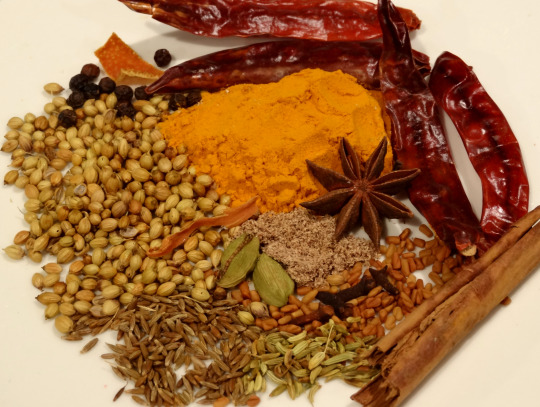
[ID: A plate of whole and ground spices including red chilis, Ceylon cinnamon, coriander seeds, and star anise. End ID]
新加坡咖哩粉 / Xinjiapo gali fen / Curry powder Singapura (Singapore curry powder)
Singapore curry powder, or gali fen ("gali" from the English "curry"), is a spice blend that was inspired by British Madras curry powder, but grew to incorporate Chinese spices and aromatics. It is representative of the culinary culture of Singapore, which incorporates influence from Chinese, Indian, Thai, Malay, and Indonesian cuisines.
This blend is used in “Singapore” curry fried noodles (actually a Hong Kongese dish) and in other Chinese curry dishes including chicken curry (新加坡式咖喱鸡), beef brisket curry (咖喱牛腩饭), curry soup noodles, and vegetable curries. It is also a popular choice for marinating meat and seafood.
Curry powder Singapura starts from a base of dried red chilis, and is rounded out with earthy spices including turmeric, coriander, cumin, and fenugreek. Warming spices such as nutmeg, mace, cinnamon, and cloves are often also included. Chinese influence sometimes appears in the form of chenpi (dried mandarin orange peel), Sichuan peppercorn, dried radish, liquorice root, star anise, and dried ginger.
Recipe under the cut!
Patreon | Tip jar
Makes about 1/3 cup.
Ingredients:
2 Tbsp (17.4g) ground turmeric / 薑黃
10 dry red chilis (11g; adjust to taste)
2 Tbsp (8g) coriander seeds / 芫茜
1 tsp (3.6g) fenugreek seeds (optional)
1 tsp (2.5g) cumin seeds / 小茴香種子
1 tsp (2g) fennel seeds / 谷茴
1 tsp (2g) ground ginger (optional)
1/2 tsp (1.6g) black peppercorns
1 inch (1.5g) Ceylon cinnamon / 桂皮
1 pod (1.4g) star anise / 八角
1g liquorice root / gan cao / 甘草 (optional)
1g chenpi / 陳皮(optional)
1g cao guo / tsao ko / 草果 / Chinese black cardamom, freshly grated (optional)
4 (1g) green cardamom pods
1/2 tsp freshly grated nutmeg / 玉果 (1/4 tsp preground; .5g)
1/4 tsp (7; .4g) cloves
2 blades mace (.2g; optional)
Liquorice root, chenpi, and cao guo may be found at an east Asian or Chinese grocery store, but may need to be purchased online. Many homemade versions of this spice blend do not include these spices.
Hong Kong curries tend to be relatively mild and sweet, including a lot of turmeric and cinnamon relative to the amount of chili and pungent spices. You should adjust the heat, sweetness, and pungency of the blend to your taste.
Instructions:
1. For a less spicy curry powder, you may choose to break open the chilis and remove all or some of their seeds.
2. Roughly crush star anise, cinnamon, nutmeg, and cardamom pods in a mortar and pestle or with the flat of a knife. In a small, dry skillet, toast whole spices (coriander, fenugreek, cumin, black pepper, cinnamon, fennel, star anise, nutmeg, cardamom, Sichuan peppercorn, cloves, and mace) one at a time until each is fragrant. Set aside and allow to cool.
Spices are toasted one at a time so that smaller spices don't burn before larger ones are fully fragrant. Sometimes, I'll toast larger spices (such as cloves and cardamom pods) together, and then toast smaller seeds (such as cumin) together, to speed up the process.
3. Remove pan from heat. Toast ground spices (turmeric, and anything else you used a ground version of) for 30 seconds, stirring constantly, and remove from the skillet.
4. Grind liquorice root in a spice mill or coffee grinder until as fine as possible, then pass it through a sieve to remove larger pieces. Return those pieces to the mill and grind again. This is done separately because liquorice root can be tough to grind!
5. Grind all spices in a spice mill until fine. Pass through a sieve. Store in an airtight container in a cool, dry place.
72 notes
·
View notes
Text
Authentic Chinese 5-Spices Powder
A versatile spice mix unique to Chinese cuisine, 5-spices powder adds great flavour to many classic dishes. It’s very easy to make at home.

Ingredients:
10 grams whole star anise 10 grams fennel seeds 5 grams Cassia cinnamon/Chinese cinnamon 5 grams whole Sichuan pepper corns 2 grams whole white pepper corns 2 grams whole cloves

Preperation:
Step 1:
Separate the pods of star anise. Remove any black seeds and stems from the Sichuan pepper.
Step 2:
Put all the spices into a cool pan, toast over medium-low heat until fragrant (The colour of the fennel seeds darkens a little and you’d hear some popping sound). Remove from the pan and leave to cool completely.
Step 3:
Add toasted spices to a spice grinder, a mini blender or a mortar and pestle and mill until fine powder appears.
Step 4:
Pass through a fine sieve to remove any remaining bits.
Step 5:
Store the powder in an airtight jar away from direct sunlight. It can be used for up to a year or longer if its aroma stays strong.
NOTE:
In my experience, star anise, fennel seeds, cloves and white pepper can be found in mainstream supermarkets, while Sichuan pepper (also spelled Szechuan pepper corns) and Cassia cinnamon are available in Chinese/Asian stores.
If you have trouble sourcing Cassia cinnamon aka Chinese cinnamon, Cassia bark, you may replace it with Ceylon cinnamon, but reduce its quantity by half.
1 note
·
View note
Text
How are you going to leave out aromatics like garlic or onion (fresh or powdered), shallot, leek, garlic scapes, chives (FODMAP folks I’m so sorry you have to live without flavor)???
Thyme, rosemary, oregano, marjoram, and summer savory all mixed together is store brand Italian seasoning mix. Add red pepper flakes to it for heat, to taste
Can’t get zata’ar? Mexican oregano is a good substitute
Vegans: get some nutritional or brewer’s yeast (marmite/vegemite is the same thing, but wet). A little goes a long way, but it’ll give you a similar umami/salty/savory flavor to cheese and good butter
Chinese 5 spice differs from region to region but the most common combo is: cinnamon, clove, star anise, bay leaf, and Sichuan peppercorn (which you can find pretty cheaply online. Green version is more numbing than the red)
Homemade stir fry not tasting quite right? Get black vinegar, sesame oil, and shaoxing wine (a type of cooking sherry that can be found online. I get mine from Oyo Just Asian Foods and IIRC it was $10 for about a liter). And don’t be afraid of MSG. Just a pinch for a pound of meat or veggies goes a long way to boosting flavor
Lemon or white vinegar adds acidity and brightness that cuts through fatty dishes for more balanced flavor. Acidic veggies like tomatoes also do this
Need buttermilk but don’t want to buy a whole quart? Mix about a tablespoon of white vinegar into half a cup of cow milk (I’m sorry vegans it doesn’t work, chemically, with plant-based milks. It does work with lactose-free cow milk)
Add a pinch of salt to your desserts to enhance sweetness and balance flavors
Genuinely, I don’t know how else to get the word out, but I feel like if your home-cooked dinners don’t taste right, you're missing either paprika, sugar, butter, or chicken bouillon.
#if you see ‘accent’ in the store it’s MSG#and it’s delicious#I got a 1lb bag online for like $8 and use that shit in EVERYTHJNG
76K notes
·
View notes